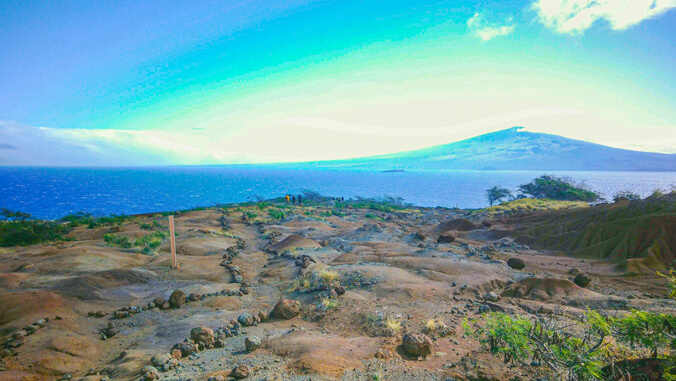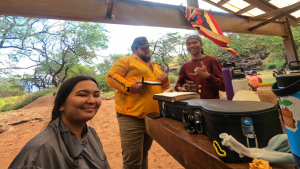
Haumāna (students) from the University of Hawaiʻi at Mānoa and UH Hilo are leaving the spring semester behind with a renewed outlook on ʻōlelo Hawaiʻi (Hawaiian language).

In an effort to sharpen students’ ʻōlelo skills, UH Mānoa Kawaihuelani Center for Hawaiian Language and UH Hilo Ka Haka ʻUla O Keʻelikōlani College of Hawaiian Language, invite haumāna to an immersive three-day retreat on Kahoʻolawe every March. The assignment: they must speak only in Hawaiian.
“We want our students to be fluent in ʻōlelo Hawaiʻi, not just fluent in reading. We want them to be functional linguistically,” said C.M. Kaliko Baker, a kumu ʻōlelo Hawaiʻi (Hawaiian language associate professor) at Kawaihuelani. “Programs like this allow students these social spaces to engage their ʻōlelo Hawaiʻi.”

Mālama (care for) Kahoʻolawe
Since 2014, the I Ola Kanaloa program spearheaded by Kawaihuelani, take haumāna on a huakaʻi (journey) to the uninhabited mokupuni (island) of Kahoʻolawe, which is only accessible by boat and requires visitors to briefly swim to shore with their ukana (baggage) in tow. Known for its deep and complex history, the island, once used as a bombing range for the military, continues to undergo slow and careful restoration.

“To see the place for the first time, to touch the water for the first time. it filled me with life that I really needed in the moment,” expressed Kaʻimi Galima-Elvena, a UH Hilo Hawaiian studies and biology student.
Daily activities on Kahoʻolawe focused on land or ʻāina-based care, and included invasive plant clearing, maintenance of historical sites and traditional protocols/ceremony.
Language of the land
Life changing is how UH Mānoa MFA Hawaiian theatre candidate Ikaika Mendez describes his experience. The Maui native grew up taking in views of Kahoʻolawe from his front porch in Ulupalakua. While on the huakaʻi, Mendez relished the challenge of communicating strictly in Hawaiʻi’s mother tongue.
“It didn’t matter what level of ʻōlelo you were, because we’re all growing,” said Mendez. “Just to be able to disconnect yourself from everything else and just be fully immersed in the work that we were doing, it’s just a great experience.”

In language there is life
One of the highlights of the retreat is haku mele (song composition). Students broke into groups and composed songs in three genres: mele aloha (love), mele wahi pana (written for a place or location), and mele maʻi (procreative).
Haumāna research the various places and moʻolelo (stories) of Kahoʻolawe, and then weave it into oli (chant), hula, mele and mele au hou (contemporary Hawaiʻi tunes).
Helping Baker guide haumāna on the spring huakaʻi are additional dedicated kumu ʻōlelo Hawaiʻi who are also recognized recording artists such as Isaac Nāhuewai (known musically as Ikaakamai) from UH Hilo, Kaʻikena Scanlan and Lāiana Kanoa-Wong from Kamehameha Schools Kapālama.

“We see that mele is an avenue to showcase the vitality of our language and culture,” said Nāhuewai about the haku mele activity. “We also see how mele is a means to educate our lāhui (nation). The language truly brings life to the ʻāina and to the lāhui and to speak and hear ʻōlelo Hawaiʻi from all huakaʻi participants is truly gratifying.”
Funding for the trip is made possible by Kawaihuelani and Hale Kuamoʻo Hawaiian Language Center at UH Hilo.

